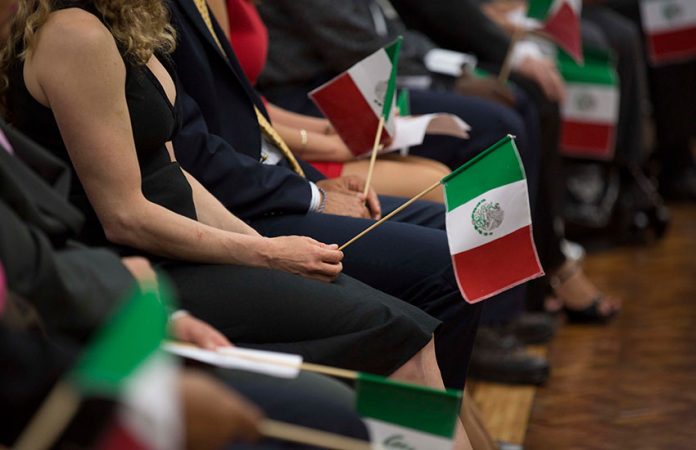In both perception and reality, Mexico is currently a net “sender” when it comes to migration, as images from the U.S.-Mexico border remind us.
Although Mexico has never received the large number of immigrants the way countries like the U.S. and Argentina have, foreigners have indeed come here looking for a better life, with many of the benefits and challenges such influxes create.
According to Mexican government statistics, less than 1.2 million of Mexico’s nearly 127 million residents are foreign-born — this despite the fact that its tourism industry brings over 38 million visitors each year.
Oddly, the U.S. State Department estimates that 1.6 million Americans alone live in Mexico at least part of the year. The discrepancy is likely due to different definitions of “resident.”
Americans are considered the largest immigrant group by Mexican authorities, accounting for over 66% of the total. In second place right now is Venezuela with only 6%. Interestingly, most who get official permanent residency are from South America.
These and other statistics are a snapshot of the political and social realities that shape immigration to Mexico, always subject to change.

Like immigrants the world over, Mexico’s arrivals factor in economic, political, cultural and social issues in their decision to come. We could add digital technology, as it allows migrants to keep ties back home as well as provides ways of making a living in Mexico.
One difference between immigration to Mexico and say, the United States, is that Mexico attracts migration from countries both more and less affluent than it is.
The arrivals of the conquering Spanish and the relatively short-lived importation of African slaves did add new peoples to Mesoamerica, but “immigration” by its modern definition started in the 19th century, with the arrival of French, British, Chinese, Japanese and later, North Americans. They have impacted Mexico’s economy, culture, politics, law and international relations.
This history has been woefully understudied even in Mexico itself, as the word “migración,” even here, conjures the thought of people leaving for the U.S.
European industrialists began arriving soon after Independence, looking for opportunities, especially in textiles and mining. But it was not always smooth. The first French Intervention (1838–1839) occurred when Paris intervened in Mexican affairs on behalf of French living in the country.
Late in the 19th century, foreign investment was heavily encouraged by the Porfirio Díaz regime, looking to modernize Mexico’s economy. Generous concessions were made to foreign companies in mining, oil, agriculture and more, who brought experts and even common workers to the country. One lasting legacy from this time period is Mexico’s obsession with football/soccer, which can be traced to British miners in Hidalgo.

The jewel of modernization at the time was the railroad, and Chinese laborers were brought over for the back-breaking work of laying the lines. These immigrants founded Chinatowns up and down the west side of the country, but they were never accepted. When the Mexican Revolution broke out, Chinese nationals (along with Mexican spouses and children) were subject to expulsion to China and the U.S., and even violence.
On the flip side, Mexico has provided asylum on various occasions, such as to Russian Jews in the 1880s. But the most famous example is the migration of Spanish and other European artists and intellectuals fleeing fascism and war in the mid-20th century, whose impact on Mexican art and letters cannot be overstated.
Over the 20th century, the makeup of foreign residents changed radically. At the beginning of the century, most were from Spain, whose citizens still enjoy advantages under immigration law. But in the mid-century, Americans would begin to dominate, forming enclaves such as San Miguel de Allende and Ajijic.
Most are economic migrants, but unlike economic migrants in the U.S. and Europe are. The attraction for those from developed countries is a lower cost of living along with the ease of flying home. This initially brought retirees on fixed incomes, but in the last decades, digital nomads have become prominent with the ability to work online.
More “traditional” economic migrants to Mexico are generally from Central and South America and increasingly, the Caribbean, but people have come here from just about everywhere on the globe. Many are passing through trying to get to the United States, meaning that Mexico may be such migrants’ first or second choice.
Some are welcome, like the uptick in unemployed young professionals from Spain after the global financial crisis in 2008, but many are not. Although race is a factor, especially for those from Asia and Africa, the issue is most commonly socioeconomic class.

Immigration law continues to evolve since the country’s independence. Invasions by the French, the Americans, and the loss of Texas, have led to laws restricting the rights of foreigners (most notably property rights and political speech), along with a kind of “second-class” status for naturalized citizens. But most importantly, perhaps, is that Mexican immigration law favors those with economic means and from developed and/or Spanish-speaking countries.
With immigration issues causing problems on both of Mexico’s borders, Mexico’s laws and policies are likely to evolve, especially as the social, political and economic situation in the United States changes. One hundred years from now, who migrates to Mexico might be very different from those coming today.
Leigh Thelmadatter arrived in Mexico over 20 years ago and fell in love with the land and the culture in particular its handcrafts and art. She is the author of Mexican Cartonería: Paper, Paste and Fiesta (Schiffer 2019). Her culture column appears regularly on Mexico News Daily.
